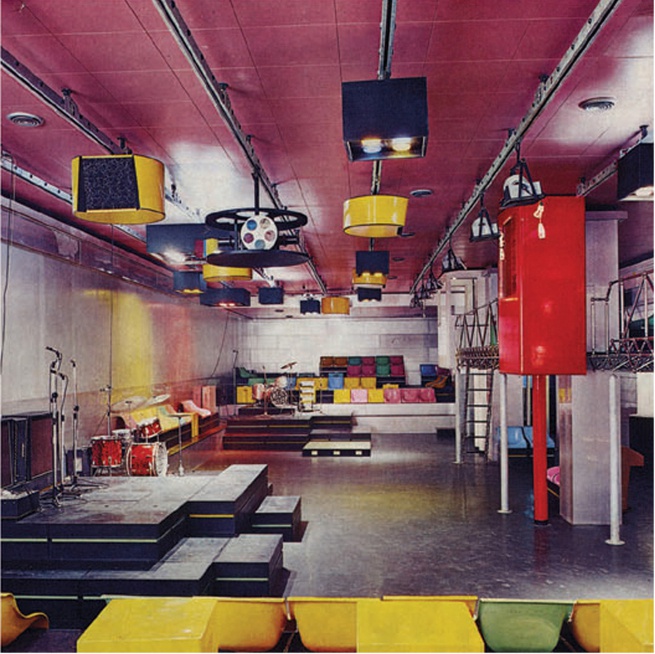In Pictures: The radical Italian discos of the '60s and '70s
- Text by HUCK HQ

The 1960s and 1970s were a brief period of clubbing utopia in Italy where a wave of radical architecture groups started transforming spaces in an ideological way.
The era, brought to life in a new show at the ICA London: Radical Disco: Architecture and Nightlife in Italy, 1965-1975 until January 10, featured experimental architecture groups such as Gruppo 9999, Superstudio and UFO who were bored with postwar modern design and wanted to create something that would make clubbers think, as opposed to escape.

The stage and audio-visual system inside La Fine del Mondo, designed by Pietro Derossi, Giorgio Ceretti and Riccardo Rosso, Turin, 1966. © Pietro Derossi

Interior of La Fine del Mondo, designed by Pietro Derossi, Giorgio Ceretti and Riccardo Rosso, Turin, 1966. ©Pietro Derossi
An early inspiration for some of the designers in the show was Carlo Mollino’s Le Roi Dancing in Turin. According to design journalist Alice Rawsthorn: “A dancehall, rather than a disco, Le Roi Dancing was built from scratch in an old scrap metal yard in 1959 by a local impresario Attilio Lutrario, who commissioned Mollino to design the interior. Known as the “dark prince” of mid-20th century Italian design, Mollino worked mostly in Turin with a crew of trusted local artisans. Like all of his projects, Le Roi combined colour, form and light to dramatic effect.”

Carlo Mollino’s Le Roi Dancing in Turin
One of the stand-out clubs in the exhibition is Bamba Issa in Forte de Miami by architect Titti Maschietto whose father bought a villa in the area and renovated it into a hotel. Maschietto decided it was the perfect place for UFO to put their theories into practice. According the Guardian: “Bamba Issa took its inspiration from a Disney comic book, Donald Duck and The Magic Hourglass, which UFO felt was “an allegory for capitalism, its arrogance and shortcomings”. The club’s design reflected the comic’s look: it had large lanterns, hourglass-shaped furniture, a DJ booth apparently on a flying carpet.”

UFO, lovers on a swing chair, Bamba Issa, Forte dei Marmi, 1970. Photograph by Carlo Bachi, © Lapo Binazzi, UFO Archive.

UFO, amphibious camels returning to Africa, Bamba Issa, Forte dei Marmi, 1969. Photograph by Carlo Bachi, © Lapo Binazzi, UFO Archive.
Co-curated by Dr Catharine Rossi and Sumitra Upham, Radical Disco drops at the ICA London at a time when nightclubs are closing across the UK and the idea of clubs as important cultural spaces needs some serious consideration.
Radical Disco: Architecture and Nightlife in Italy, 1965-1975 is at the ICA London until January 10.
Latest on Huck

Why London’s queers are flocking to line dance
Stud City — With a global boom in the popularity of country music, a host of new nights attended by LGBTQ+ folk are opening in the UK’s capital. Zoe Paskett went along to find out about the community’s love for the hustle.
Written by: Zoe Paskett

“My homeland Is everywhere”: Samantha Box is redefining contemporary photography
Confluences — Finding the boundaries of documentary photography too limiting, the US-based photographer has developed a style entirely her own as a canvas to explore her overlapping identities.
Written by: Miss Rosen

In the ’60s and ’70s, Greenwich Village was the musical heart of New York
Talkin’ Greenwich Village — Author David Browne’s new book takes readers into the neighbourhood’s creative heyday, where a generation of artists and poets including Bob Dylan, Billie Holliday and Dave Van Ronk cut their teeth.
Written by: Cyna Mirzai

How Labour Activism changed the landscape of post-war USA
American Job — A new exhibition revisits over 70 years of working class solidarity and struggle, its radical legacy, and the central role of photography throughout.
Written by: Miss Rosen

Analogue Appreciation: Emma-Jean Thackray
Weirdo — In an ever more digital, online world, we ask our favourite artists about their most cherished pieces of physical culture. Today, multi-instrumentalist and Brownswood affiliate Emma-Jean Thackray.
Written by: Emma-Jean Thackray

Meet the shop cats of Hong Kong’s Sheung Wan district
Feline good — Traditionally adopted to keep away rats from expensive produce, the feline guardians have become part of the central neighbourhood’s fabric. Erica’s online series captures the local celebrities.
Written by: Isaac Muk